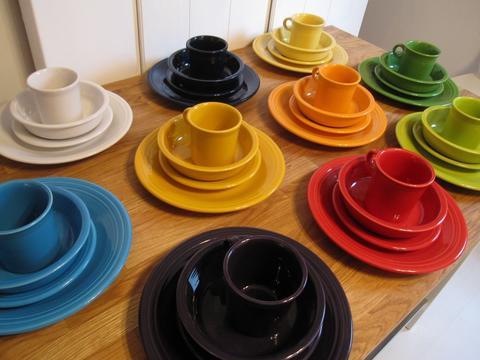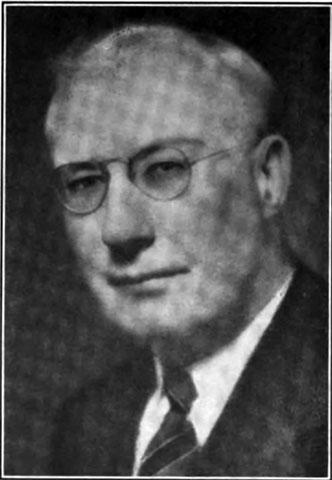Dinner Is on Us: NIST and the Creation of Fiestaware

Samples of Fiestaware. This popular style of ceramic tableware is just as likely to be seen exhibited in museums as it is to be used on the average family’s dinner table.
I can’t say for certain, but it’s likely Albert Bleininger is the only NIST scientist to have had his work featured on the popular PBS TV program “Antiques Roadshow.” I also can’t say for certain, but it’s likely that you own a piece of his work. Even if you don’t, you’d recognize it if you saw it. It has been manufactured for 80 years now, and is the best-selling style of ceramic tableware ever produced.* Not just commercially successful, but also critically praised, Bleininger’s work would “rewrite the history of industrial design,” as art historian Sharon Dale put it. Brightly colored yet simple in style, the popular tableware Bleininger helped create came to be called Fiestaware.
Albert Bleininger died in 1946, many decades before “Antiques Roadshow” would air. But had he been around to see the episode that featured Fiestaware, he would have been surprised. This was not how he envisioned being remembered.
In 1920, before the invention of Fiestaware, Bleininger was the head of the clay products division of the National Bureau of Standards (NBS, now called NIST). He was nearing 50 years old, close to retirement age in that era. He had already accomplished much in his career. He was considered a leading figure in the scientific study of ceramics, and was a founding member and former president of the American Ceramic Society. It was that year that Bleininger announced he was leaving NBS to take a higher-paying position with a private-sector consumer ceramics manufacturer. Probably recognizing that he was entering the final phase of his career, he gave an interview with a trade journal in which he wistfully described his decade-long tenure at NBS as his “life’s work.” And that is the work Bleininger would have been remembered for, if Homer and Shakespeare hadn’t intervened.
Two brothers, Homer and Shakespeare Laughlin, founded the Homer Laughlin China Company in 1874. According to a history of the company, “By the 1920s, modern technology was affecting the age-old ways that pottery was produced, and management saw the necessity of bringing trained scientists into the company on a full-time basis.” The high salary they offered Bleininger to lure him away from his “life’s work” at NBS would prove to be worth it. Bleininger immediately set about applying the knowledge he had gained from his years of NBS research to improving the Laughlin Company. He oversaw the design and construction of tunnel kilns to replace older inefficient kilns, essentially instituting an assembly-line system for firing ceramics that increased production and lowered costs.
Having a well-respected scientist such as Bleininger on staff allowed the Laughlin Company to attract other talent. One recruit was designer Frederick Hurten Rhead, who knew Bleininger from their mutual association with the American Ceramic Society. Rhead, who joined the company in 1927, was known for his art pottery, some of which is now in the permanent collection of the Metropolitan Museum of Art in New York City. For Laughlin, Rhead crafted a new design for tableware made up of simple concentric lines. This gave the work a handcrafted look, as if it had been produced on a potter’s wheel, yet at the same time was also streamlined in the contemporary style of Art Deco.
But the tableware’s real claim to fame was its color. It used colored glazes developed by Bleininger. The glazes he created were unique, incorporating the mineral uranium to produce colors that were exceptionally vibrant, even when applied as a matte finish. The company described the uranium glazes as “harmlessly radioactive.”
The new tableware was named Fiesta, and was introduced to the public in 1936. Fiesta offered a splash of color and modern styling at a time when white tableware and floral patterns were common. Bleininger’s efficiency improvements to the Laughlin Company’s production allowed the company to market Fiesta at prices that appealed to the cost-conscious middle class. The company made the purchase of Fiesta even more economical by selling it as individual pieces rather than in full sets. Fiesta originally came in five complementary colors—orange red, cobalt blue, light green, deep golden yellow, and “old ivory” (yellowish cream)—allowing consumers to mix and match the colors and pieces to their own personal taste and budget.
The combination of color, style and an affordable price made Fiesta an enormous commercial success. Those three attributes were either directly or indirectly attributable to former NBS scientist Albert Bleininger.
Fiesta, which came to be more commonly known as Fiestaware, remains popular today. Its original five colors have now expanded to 47, and Fiestaware is still produced at the Homer Laughlin Company’s factory in Newell, W.Va., where public interest is so strong that tours of the facility are offered. As evidenced by its appearance on "Antiques Roadshow," vintage Fiestaware has also become a collector’s item, with some pieces selling for thousands of dollars.
During World War II, uranium became a strategic commodity, and Bleininger’s original glazes were reformulated to exclude the use of the radioactive material. That has made pre-war Fiesta the rarest of the breed and thus the most sought after by collectors (and by radiation physicists too, I am told). Pre-war uranium-containing Fiestaware is generally considered safe to own, but it is recommended that you avoid using it to serve food.
Because Fiestaware has been so popular with the general public and has been in production for so long, it’s easy to overlook its importance. The nation’s premier museum dedicated to design, the Smithsonian’s Cooper Hewitt, has in its collection Fiestaware pieces that you might just as easily come across at any neighborhood antique store. Commenting on this juxtaposition, art historian Sharon Dale in her book discussing Fiestaware states, “We should not trivialize the impact of Fiesta, for it was and remains a hallmark in American industrial design—modern, sleek, free of vestigial historicism, and an unabashed success in a market that supposedly resisted design innovation.”
That last phrase strikes me as fitting. Albert Bleininger carried the NIST knack for innovation into the supposedly resistant consumer ceramics market, changing it in ways that are still being discussed, on primetime television even, 80 years after his Fiestaware was first produced.

*“Why America Still Gets Fired Up Over Fiestaware,” Robert Klara. ADWEEK, October 12, 2014; and "Frederick Hurten Rhead," Sharon Dale. American Ceramics, Vol. 5 (Fall 1986), pp. 41-45.
Originally published in NIST Connections: A Newsletter for NIST Employees and Associates, February 2017.
Contacts
-
(301) 975-2789

